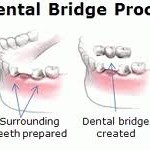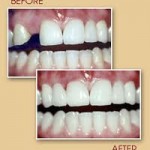 Having a missing tooth and worried about presence of a gap between your teeth which disrupts your daily social life and compromises your appearance. Worry less as dental bridges offer a great solution by closing the gaps. A false tooth is held in the open space at the gum line by attaching it to teeth on either side of the missing tooth. If several teeth are missing, artificial teeth are glued together and attached to adjacent real teeth. Dental implants and removable partial denture are other options available to replace missing tooth. Likewise other dental procedures, dental bridges have its advantages and disadvantages as well.
Having a missing tooth and worried about presence of a gap between your teeth which disrupts your daily social life and compromises your appearance. Worry less as dental bridges offer a great solution by closing the gaps. A false tooth is held in the open space at the gum line by attaching it to teeth on either side of the missing tooth. If several teeth are missing, artificial teeth are glued together and attached to adjacent real teeth. Dental implants and removable partial denture are other options available to replace missing tooth. Likewise other dental procedures, dental bridges have its advantages and disadvantages as well.
Dentist will carefully examine your dentition and health of your gums. This is followed by preparation of teeth that are going to support a bridge known as abutment teeth. Abutment teeth needs to be healthy, devoid of any large restorations, decay or fractured. Poor oral hygiene, heavy smoking, or supporting teeth which are mobile, are contraindicated for bridges.
 The procedure begins by anesthetizing the involved tooth so that it helps in carrying out the procedure. The enamel is shaved off according to the type of fixed bridge planned sufficient to fabricate material to restore the size, shape and appearance as in natural teeth. Dentist then takes an impression or mould of the final preparation and sends it to the lab. A model is fabricated and the false tooth or pontic and crowns are constructed accordingly. Meanwhile, a temporary bridge is fitted to protect the exposed teeth and gums which may cause extreme sensitivity, prevent fracture of the remaining tooth tissue and maintaining the angulation and alignment of the prepared teeth.
The procedure begins by anesthetizing the involved tooth so that it helps in carrying out the procedure. The enamel is shaved off according to the type of fixed bridge planned sufficient to fabricate material to restore the size, shape and appearance as in natural teeth. Dentist then takes an impression or mould of the final preparation and sends it to the lab. A model is fabricated and the false tooth or pontic and crowns are constructed accordingly. Meanwhile, a temporary bridge is fitted to protect the exposed teeth and gums which may cause extreme sensitivity, prevent fracture of the remaining tooth tissue and maintaining the angulation and alignment of the prepared teeth.
The type of bridge depends entirely on the patient’s specific condition. The location of the missing teeth and the amount of pressure the area receives are the main factors in determining the type of dental bridge used.
- Cantilever Bridges in which only one tooth is trimmed and fitted with a crown, can be used in preservation of tooth structure and usually preferred in areas with less chewing stress and in front teeth.
- Adhesive Resin-Bonded or Maryland Bridges are used for the front teeth with sound adjacent tooth, requires less preparation and cutting off tooth structure.
- Conventional Bridges are the most common bridge chosen. The two adjacent teeth next to the empty space is prepared to seat a crown and a pontic is placed in the middle, ensures maximum support since the force is equally distributed to the neighbouring teeth.
- They have a natural appearance.
- Smile is restored and maintains the shape of your face.
- Time-saving as it requires only two visits to the dentist.
- Cost-effective and are less expensive when compared to dental implants.
- They are long lasting for about 10-15 years with good oral hygiene.
- Fixed and stable, the wearer will not have to worry about bridgework falling out.
- Less invasive than implant procedures which requires surgery and prolonged healing.
- Chewing efficiency is increased as more force can be generated without having to worry about the damage potentially caused to a denture.
- Speech problems are addressed as missing teeth are replaced.
10. Forces are distributed equally during bite phase and increased function.
11. Adjacent tooth is prevented from drifting into the empty space left by missing tooth, altering the bite and leading to temperomandibular disorders.
12. Drifted tooth can cause food stagnation and thereby increasing the risk of periodontal diseases and dental decay.

- Sensitivity is likely to be experienced to extreme changes in temperature on consuming hot and cold drinks for a few weeks.
- Teeth and gums are susceptible to infection due to bacterial accumulation from acidic food in the absence of proper oral hygiene.
- Smoking can aggravate failure of dental bridges as it harbors bacterial growth.
- Healthy adjacent tooth tissue is mandatory to construct a dental bridge.
- Poor oral hygiene compromises the success of a dental bridge. Regular brushing and flossing is crucial so that it lasts longer. Visit the dentist regularly to constantly update the status of your fixed replacement tooth.
- Cemented bridge may sometimes become loose resulting in failure of the anchoring teeth.
- They are not permanent and require replacements over the years. Repeated trauma to the tooth can cause decay and allow them to fall out.
- Adhesive bridges are not as strong as conventional bridges and metal framework may show through affecting the natural translucency of the tooth.
- Extra load on the supporting teeth can weaken, break or cause pulpal death in these teeth.
10. High alcohol consumption can break the seal of the cement and dislodge the bridge. Therefore, be cautious in using an alcohol-based mouthwash and avoid alcohol as much as possible.
11. Crowns on the anchor teeth are made of all ceramic materials or ceramic material fused on metal, may be fragile and can fracture while chewing on hard textured food. The false teeth may also break or get chipped. Avoid eating rough and hard textured foods. Minimal fractures may be repaired or otherwise replacement bridges are needed which increases the cost.
12. Bridges made of ceramic materials may become rough in time and a rough surface that constantly presses against your natural teeth can damage the enamel of these teeth. Visit your dentist to get these rough surfaces polished.
Source link
